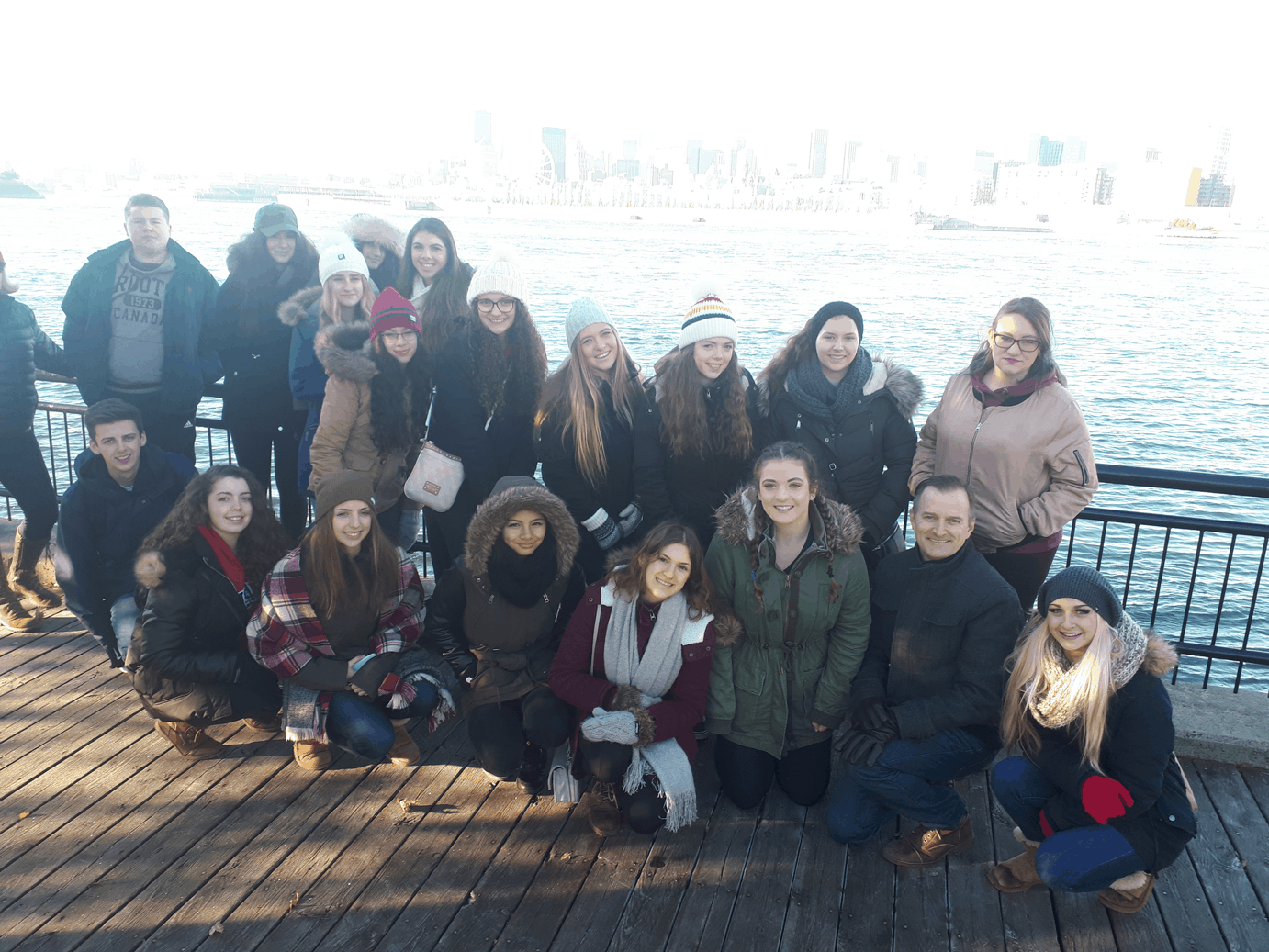 Memories of school Educational trips are said to be among the most memorable of the formative years. Growing up I never had a chance to go on any school field trips outside of the city so I was ecstatic when I found out I was invited to tag along with a recent student tour organized by Prometour. Waterdown District High School, located in Hamilton Ontario, sent one of their teachers Mr. Smith and his students to the city of Montreal as a part of his Urban Geography class in hopes of educating his students on Montreal's geographical space and study everything from the city’s architecture, spatial distribution, evolution, growth, and history.
As it turns out, Montréal is an interesting study in the diversity of its physical geography. Not only is Montréal a bona fide island, it’s the largest island in what’s called the Hochelaga Archipelago and the second most populated river island on the planet. During the three day tour, the students traveled across the city starting in the heart of downtown Montreal and visiting various locations including Île Sainte-Hélène – home to the Biosphere, La Ronde amusement park, the Québec fireworks competition and concert events like Osheaga and ÎleSoniq. While there, we learned that Île Notre-Dame is, in fact, an artificial island created in ten months using 15 million tons of excavated rock from Montréal’s then-new metro system. Together with Saint Helen's Island, it makes up Parc Jean-Drapeau, which forms part of the Hochelaga Archipelago and home to the Montréal Casino, the Olympic Basin (the largest man-made rowing basin in North America) and the Canadian F1 Grand Prix. As it turns out, the famous race track is also used for rollerblading, biking and other outdoor activities throughout the year and thanks to our amazing tour guide, we had the chance to drive around the entire track. Before leaving we also made a stop in front of Habitat 67, a model community and housing complex designed by Israeli/Canadian architect Moshe Safdie. It was originally conceived as his master's thesis in architecture at McGill University and then built as a pavilion for Expo 67, the World's Fair held from April to October 1967. And on the way back downtown we learned about the iconic Farine Five Roses sign, a staple in the Montréal skyline that's been around in some form since 1948. The massive neon that greets you when you drive towards the island is a significant landmark, charged with the province’s own tumultuous history.
Memories of school Educational trips are said to be among the most memorable of the formative years. Growing up I never had a chance to go on any school field trips outside of the city so I was ecstatic when I found out I was invited to tag along with a recent student tour organized by Prometour. Waterdown District High School, located in Hamilton Ontario, sent one of their teachers Mr. Smith and his students to the city of Montreal as a part of his Urban Geography class in hopes of educating his students on Montreal's geographical space and study everything from the city’s architecture, spatial distribution, evolution, growth, and history.
As it turns out, Montréal is an interesting study in the diversity of its physical geography. Not only is Montréal a bona fide island, it’s the largest island in what’s called the Hochelaga Archipelago and the second most populated river island on the planet. During the three day tour, the students traveled across the city starting in the heart of downtown Montreal and visiting various locations including Île Sainte-Hélène – home to the Biosphere, La Ronde amusement park, the Québec fireworks competition and concert events like Osheaga and ÎleSoniq. While there, we learned that Île Notre-Dame is, in fact, an artificial island created in ten months using 15 million tons of excavated rock from Montréal’s then-new metro system. Together with Saint Helen's Island, it makes up Parc Jean-Drapeau, which forms part of the Hochelaga Archipelago and home to the Montréal Casino, the Olympic Basin (the largest man-made rowing basin in North America) and the Canadian F1 Grand Prix. As it turns out, the famous race track is also used for rollerblading, biking and other outdoor activities throughout the year and thanks to our amazing tour guide, we had the chance to drive around the entire track. Before leaving we also made a stop in front of Habitat 67, a model community and housing complex designed by Israeli/Canadian architect Moshe Safdie. It was originally conceived as his master's thesis in architecture at McGill University and then built as a pavilion for Expo 67, the World's Fair held from April to October 1967. And on the way back downtown we learned about the iconic Farine Five Roses sign, a staple in the Montréal skyline that's been around in some form since 1948. The massive neon that greets you when you drive towards the island is a significant landmark, charged with the province’s own tumultuous history.
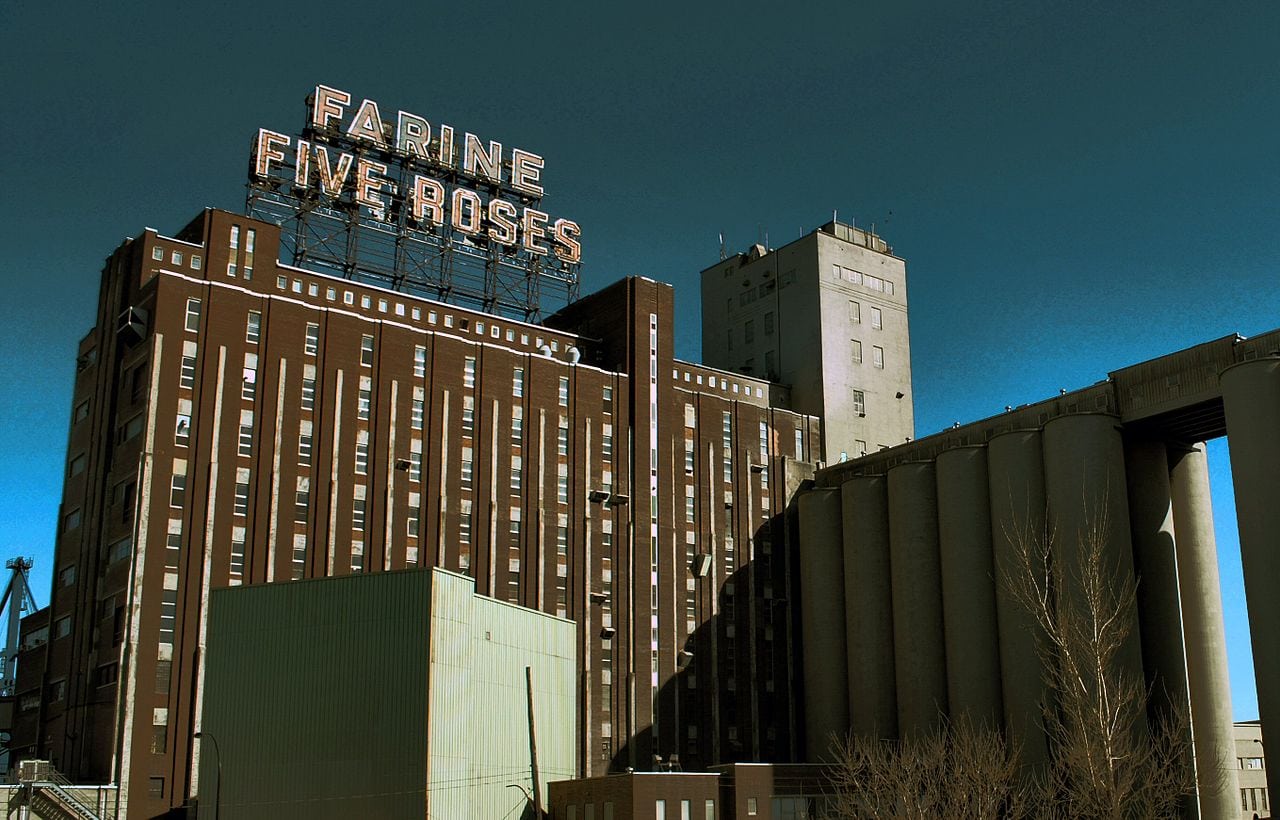
 Later in the day we also had the opportunity to visit Mount Royal. Known as the centerpiece of Montréal, the mountain stands 233 meters and is an iconic symbol of the city. The year-round public park rewards those who make their way to the summit. From there unfolds a magnificent panorama of the Île de Montréal and a view of many iconic landmarks including St. Joseph’s Oratory, the former Royal Victoria Hospital, Percival Molson Memorial Stadium (where Montréal’s pro football team, the Alouettes, play) and the Mount Royal Cross. We also learned that Mount Royal is the deep extension of a vastly eroded ancient volcanic complex, which was probably active about 125 million years ago and that a law was passed to prevent anyone from building a skyscraper taller than the cross sitting at the top of the mounting.
Montréal is also home to some fairly monumental, iconic man-made creations. Among these would be Mary Queen of the World Cathedral, which was inspired by Saint Peter’s Basilica in Rome. Built between 1870 to 1894, it was the first building in Montréal to cost more than one million dollars and includes a grand dome ceiling, a great organ built by Casavant Frères, a red copper, a gold leaf baldachin, nine beautiful paintings depicting historical events in the early days of Montréal and legendary sculptor Louis-Philippe Hébert’s White Crucifix, considered to be one of the most important pieces of religious sculpture in Québec. Of all the stops we made, the Cathedral may have been my personal favourite.
Later in the day we also had the opportunity to visit Mount Royal. Known as the centerpiece of Montréal, the mountain stands 233 meters and is an iconic symbol of the city. The year-round public park rewards those who make their way to the summit. From there unfolds a magnificent panorama of the Île de Montréal and a view of many iconic landmarks including St. Joseph’s Oratory, the former Royal Victoria Hospital, Percival Molson Memorial Stadium (where Montréal’s pro football team, the Alouettes, play) and the Mount Royal Cross. We also learned that Mount Royal is the deep extension of a vastly eroded ancient volcanic complex, which was probably active about 125 million years ago and that a law was passed to prevent anyone from building a skyscraper taller than the cross sitting at the top of the mounting.
Montréal is also home to some fairly monumental, iconic man-made creations. Among these would be Mary Queen of the World Cathedral, which was inspired by Saint Peter’s Basilica in Rome. Built between 1870 to 1894, it was the first building in Montréal to cost more than one million dollars and includes a grand dome ceiling, a great organ built by Casavant Frères, a red copper, a gold leaf baldachin, nine beautiful paintings depicting historical events in the early days of Montréal and legendary sculptor Louis-Philippe Hébert’s White Crucifix, considered to be one of the most important pieces of religious sculpture in Québec. Of all the stops we made, the Cathedral may have been my personal favourite.
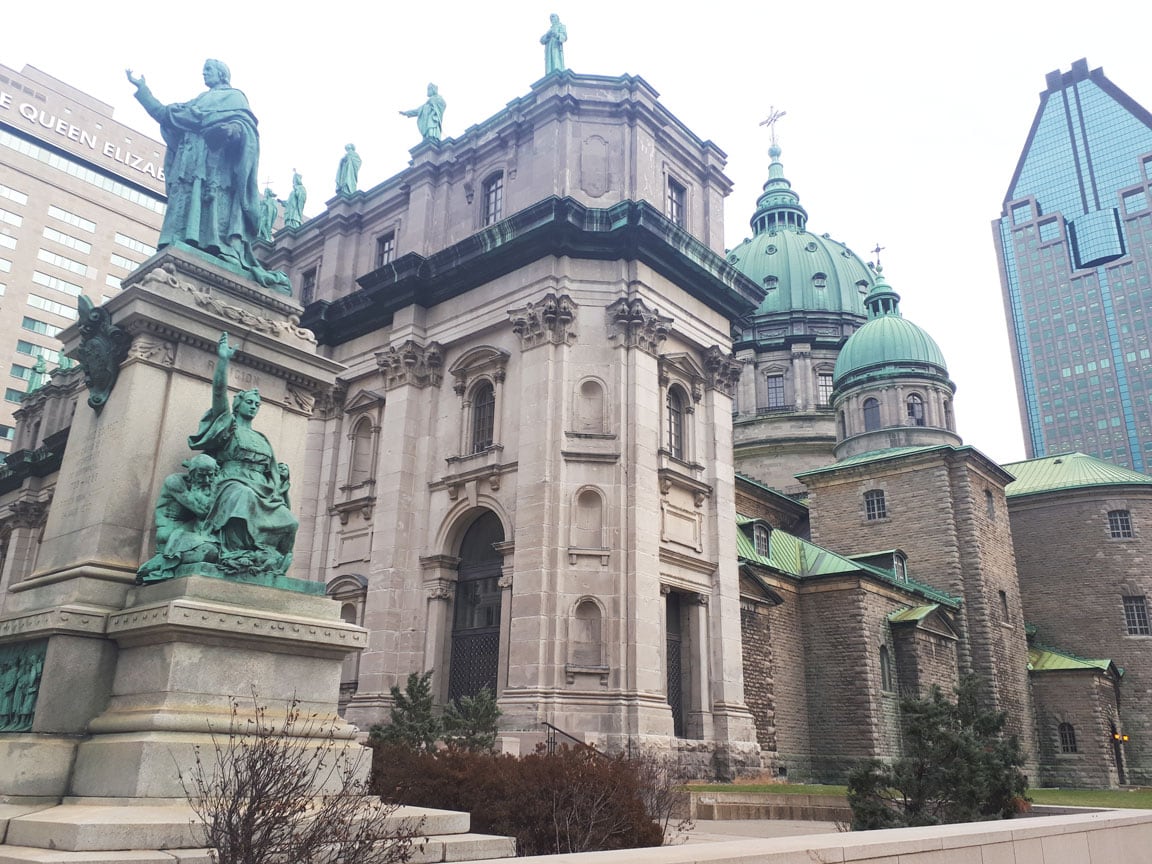
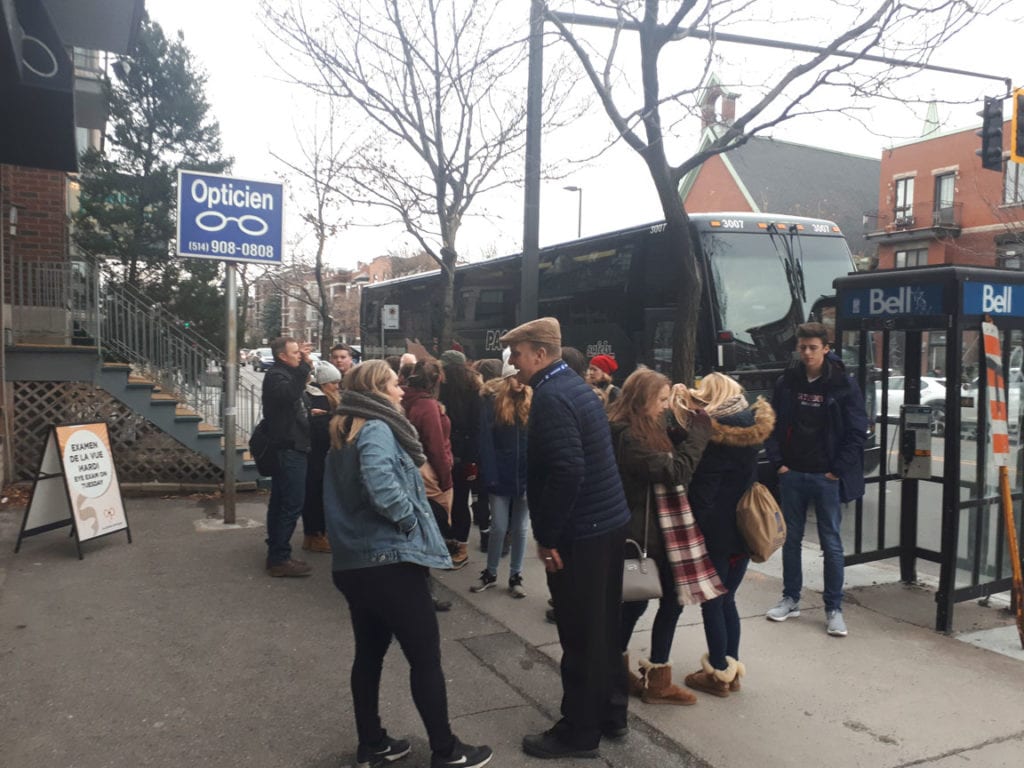 Between the many amazing sights and places we visited, the best moments of the tour were the spontaneous ones such as when the students simultaneously sang out loud the Canadian National Anthem in the center of Montreal Central Station, and the last minute stop at St-Viateur Bagel, one of the oldest and most famous bagel shops in the city. Montreal bagels are one of the city's major claims to food fame, handmade, baked in special wood-fired ovens, and dipped in honey-sweetened water. Our tour guide was generous enough to buy everyone a bag of bagels while educating us on how Montreal bagels, like the similarly shaped New York bagel, were brought to North America by Jewish immigrants from Poland and other Eastern European countries and that the differences in texture and taste reflect the style of the particular area in Poland in which the immigrant bakers learned their trade.
Between the many amazing sights and places we visited, the best moments of the tour were the spontaneous ones such as when the students simultaneously sang out loud the Canadian National Anthem in the center of Montreal Central Station, and the last minute stop at St-Viateur Bagel, one of the oldest and most famous bagel shops in the city. Montreal bagels are one of the city's major claims to food fame, handmade, baked in special wood-fired ovens, and dipped in honey-sweetened water. Our tour guide was generous enough to buy everyone a bag of bagels while educating us on how Montreal bagels, like the similarly shaped New York bagel, were brought to North America by Jewish immigrants from Poland and other Eastern European countries and that the differences in texture and taste reflect the style of the particular area in Poland in which the immigrant bakers learned their trade.
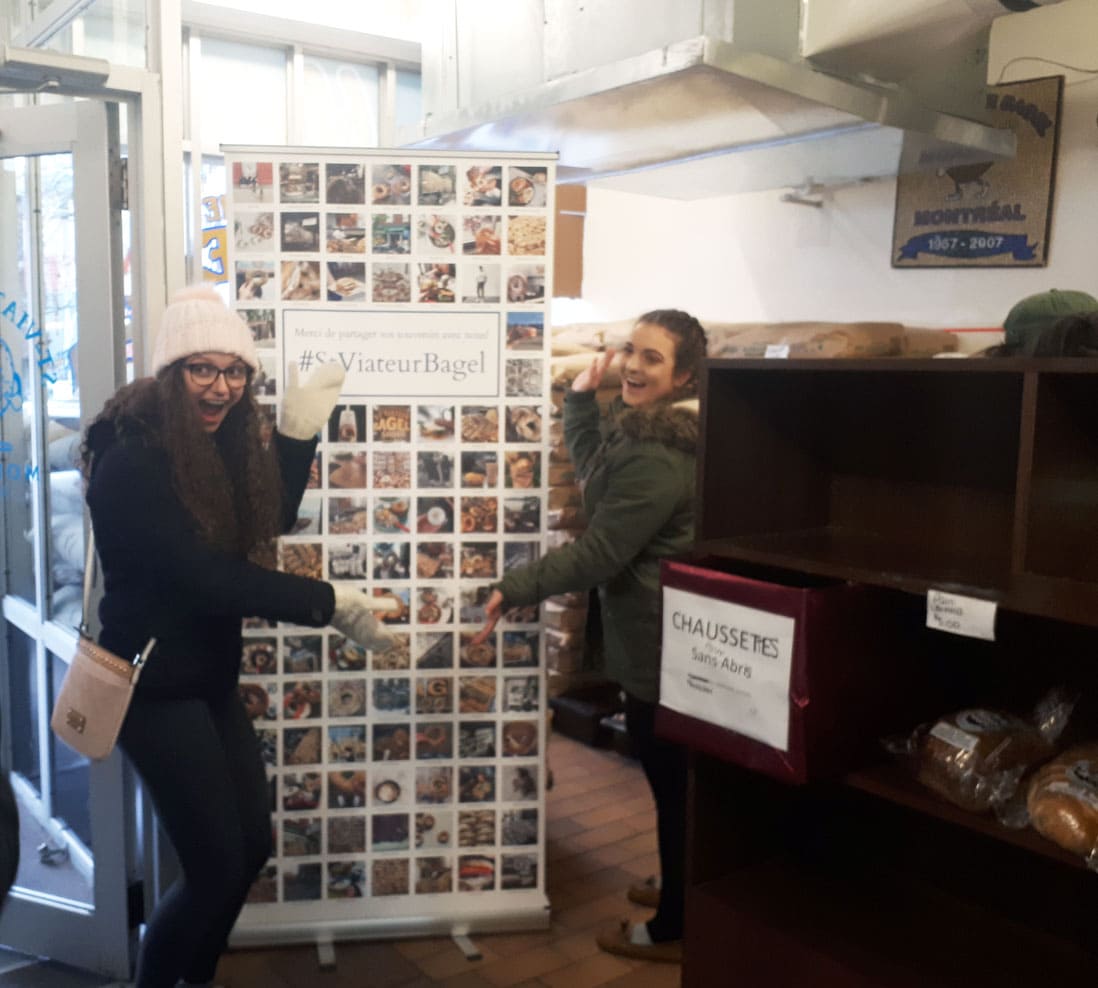
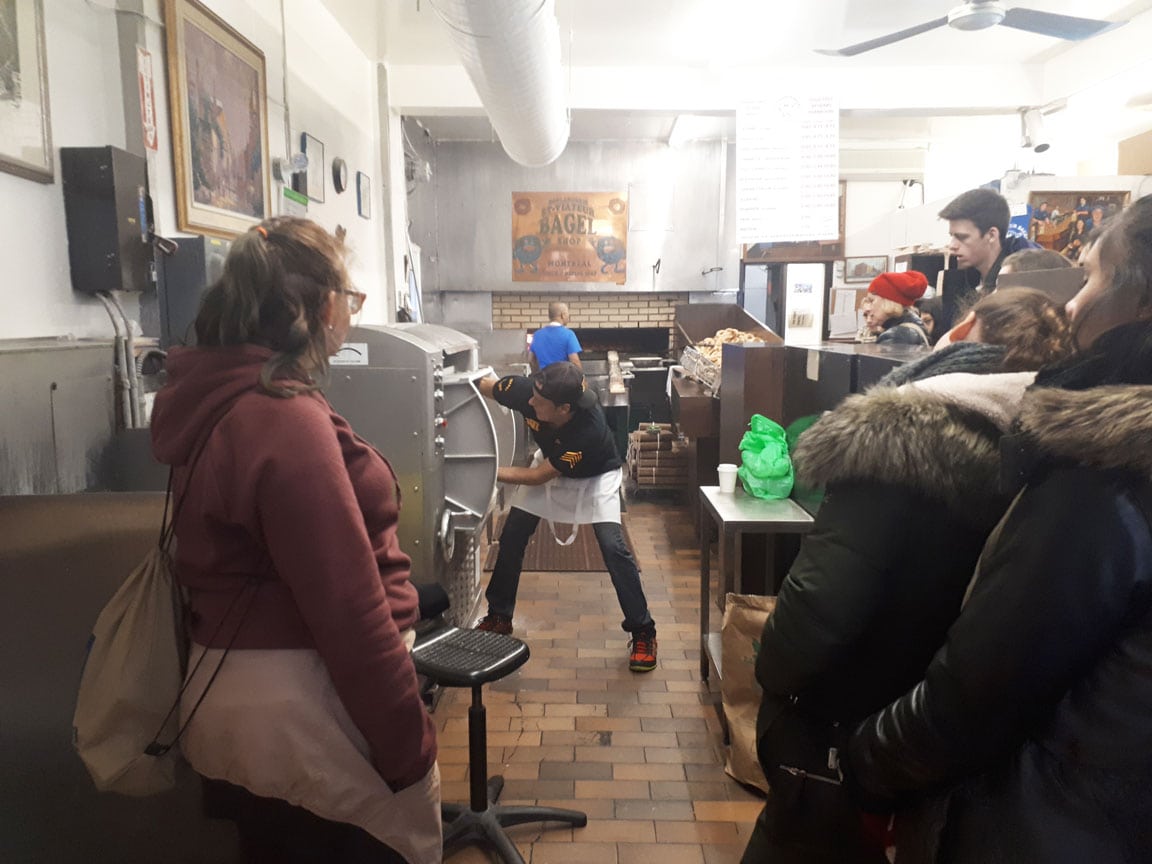 Finally, I could not end this without mentioning Cité Mémoire, a city-wide urban multimedia project featuring music and images that are projected onto the walls and floors of famous Montreal’s buildings downtown and in the Old Port. For the next four years, the trees, buildings and cobblestone streets of Old Montreal will be lit with a series of projections inspired by the history of the city and one of these that we had the chance to see is called the Interactive River, an interactive projection found in the underground passageway connecting Place Ville Marie to the Fairmont The Queen Elizabeth hotel. The project is said to symbolize the time elapsed throughout Montréal's history and reacts to people walking by, who can manipulate the visuals and generate sea foam, break its ice and move clouds. It's something you need to experience for yourself in order to fully understand the creative genius behind it.
As mentioned above, I never had the opportunity to participate in educational tours when I was younger but it didn’t take long to realize just how important these student trips are. Making Educational tours an essential part of students’ academics is an effective way to motivate them to learn more, if only because these trips are a welcome break from the classroom routine for both students and teachers. Learning something by seeing it or experiencing firsthand leaves a greater impression and more importantly, serves as a great way of bonding and developing good relationships with your peers. Personally speaking, the tour gave me a whole new perspective of the city of Montreal by bringing me in direct contact with situations and places I had never visited, or visited but never put much thought into the surroundings. Hopefully, this won’t be my last tour as I’m very much looking forward to knowing more about the world we live in.
- Ricky D
Would you like to share a story about participating on an educational tour, either as a teacher, a student, a parent or a guide? If so, we would love to feature your story on our website. Simply email our editor at info@prometour.com.
Finally, I could not end this without mentioning Cité Mémoire, a city-wide urban multimedia project featuring music and images that are projected onto the walls and floors of famous Montreal’s buildings downtown and in the Old Port. For the next four years, the trees, buildings and cobblestone streets of Old Montreal will be lit with a series of projections inspired by the history of the city and one of these that we had the chance to see is called the Interactive River, an interactive projection found in the underground passageway connecting Place Ville Marie to the Fairmont The Queen Elizabeth hotel. The project is said to symbolize the time elapsed throughout Montréal's history and reacts to people walking by, who can manipulate the visuals and generate sea foam, break its ice and move clouds. It's something you need to experience for yourself in order to fully understand the creative genius behind it.
As mentioned above, I never had the opportunity to participate in educational tours when I was younger but it didn’t take long to realize just how important these student trips are. Making Educational tours an essential part of students’ academics is an effective way to motivate them to learn more, if only because these trips are a welcome break from the classroom routine for both students and teachers. Learning something by seeing it or experiencing firsthand leaves a greater impression and more importantly, serves as a great way of bonding and developing good relationships with your peers. Personally speaking, the tour gave me a whole new perspective of the city of Montreal by bringing me in direct contact with situations and places I had never visited, or visited but never put much thought into the surroundings. Hopefully, this won’t be my last tour as I’m very much looking forward to knowing more about the world we live in.
- Ricky D
Would you like to share a story about participating on an educational tour, either as a teacher, a student, a parent or a guide? If so, we would love to feature your story on our website. Simply email our editor at info@prometour.com.
